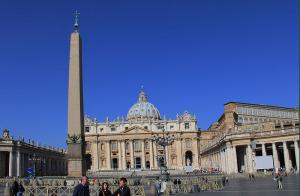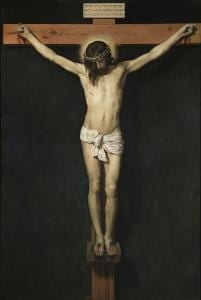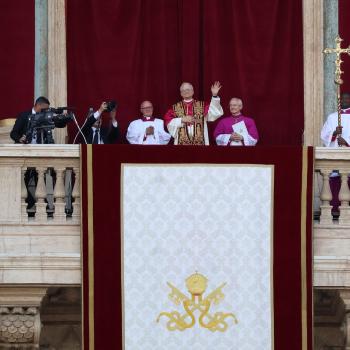An Egyptian obelisk stands in the middle of Saint Peter Square in Rome. As old as the Basilica is, the mighty obelisk is approximately 3,500 years older, and has stood by the Vatican Hill for 2,000 years. The Roman Emperor Caligula transferred this obelisk from the city of Heliopolis to Rome and installed it in the middle of the Vatican Circus in AD 37. This new sports arena was built on the side of the Vatican Hill outside the city of Rome. In the year AD 67 during the Christian persecution of Emperor Nero, Saint Peter along with hundreds of other Christians were executed at the Vatican Hill under the shadow of Caligula’s obelisk. Tradition states that Peter was crucified up-side-down next to the obelisk at the center of the arena since he was the recognized leader of the Christian community of the city.
When the first Saint Peter Basilica was built in the fourth century, the obelisk remained in its original location on the southern side of the temple. Today a marker in the Teutonic Cemetery within the Vatican walls recalls the exact location. When the present basilica was built in the sixteenth century, Pope Sixtus V ordered the obelisk moved to the middle of the new square designed by Gian Lorenzo Bernini. It took 900 men and 140 horses to move the massive obelisk in 1586.
The obelisk was crowned with a bronze cross containing a relic of the true cross of Christ, and two brief Latin inscriptions on its pedestal inform the pilgrim of its significance. The first is an exorcism prayer attributed to Saint Anthony of Padua: Ecce Crux Domini / Fugite partes adversae / Vicit Leo de tribu Iuda, which in translation means: Behold the Cross of the Lord / be gone all evil powers / the lion of the tribe of Judah has conquered. The second is an ancient acclamation used in the coronation ceremonies of Holy Roman Emperors: Christus Vincit / Christus Regnat / Christus Imperat / Christus ab omni malo plebem suam defendat, which in translation means: Christ conquers / Christ reigns / Christ commands / Christ defends His people from all evil.
The inscriptions indicate that the cross stands over the Egyptian obelisk as a sign of victory. The cross of Jesus, through his death and resurrection, has conquered all evil and fulfilled the desires of every human person expressed through the diversity of religions that have existed throughout history. The ancient obelisk pointed upward toward the sun when built in Heliopolis, but now it directs the attention of every pilgrim who arrives to Saint Peter Square to the victorious cross of Christ, protecting them and dispersing any evil that approaches.
The Christianization of Rome also saw the placement of a statue of Saint Peter over the Triumphal Column of Emperor Trajan and one of Saint Paul over the Column of Emperor Marcus Aurelius. The placement of these bronze statues in the 1500s over the ancient columns commemorating significant military conquests represents the victory of Christianity over pagan Rome.
The Feast of the Exaltation of the Cross on September 14th is a reminder for us to place the cross of Christ over everything that we are and do. Christ wants to claim each one of us entirely, and invites us to surrender completely to Him. The victory of Jesus on the cross informs everything in our lives and allows us to exclaim, “we adore you, O Christ, and we bless you, because by your cross you have redeemed the world.”
Pictures from public domain. Information here and here.















